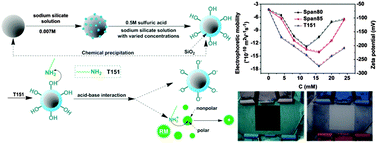Studies on the charging behaviors of copper chromite black in nonpolar media with nonionic surfactants for electrophoretic displays
Abstract
In this study, in order to serve as black particles for electrophoretic displays (EPDs), copper chromite black (CCB) particles were successfully endowed with particle charge in nonpolar Isopar L in the presence of nonionic surfactants (Span80, Span85 and polyisobutylene-mono-succinimide (T151)). Initially, the CCB particles were coated with silica (CCB/SiO2) to gain surface active spots. By measuring their electrophoretic mobility in Isopar L, it is found that all the samples possess a negative charge with a maximum of −12.95 × 10−10, −14.18 × 10−10 and −17.43 × 10−10 m2 V−1 s−1 at 12, 16 and 16 mM for Span80, Span85 and T151, respectively. Moreover, the particle charge values of the surfactant treated CCB/SiO2 particles were ordered as T151 > Span85 > Span80. These charging behaviors were discussed and interpreted from the point of charged micelles via measuring the conductivity and transient current of corresponding surfactant solutions. Significantly, a prototype EPD employing T151 treated CCB particles exhibited a quite quick response (response time: 189.6 ms) with a white–black contrast ratio of 6.27 under 0.3 V μm−1. This excellent display performance renders the CCB particles to be a promising pigment for producing the black color in electronic paper and other display applications.


 Please wait while we load your content...
Please wait while we load your content...